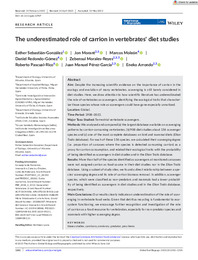Título :
The underestimated role of carrion in vertebrates' diet studies |
Autor :
Sebastián-González, Esther
Morant, Jon 
Moleón, Marcos
Redondo-Gómez, Daniel
Morales-Reyes, Zebensui
Pascual-Rico, Roberto 
Pérez-Garcí, Juan Manuel
Arrondo, Eneko |
Editor :
Wiley |
Departamento:
Departamentos de la UMH::Biología Aplicada |
Fecha de publicación:
2023 |
URI :
https://hdl.handle.net/11000/33923 |
Resumen :
Aim: Despite the increasing scientific evidence on the importance of carrion in the
ecology and evolution of many vertebrates, scavenging is still barely considered in
diet studies. Here, we draw attention to how scientific literature has underestimated
the role of vertebrates as scavengers, identifying the ecological traits that characterize those species whose role as scavengers could have gone especially unnoticed.
Location: Global.
Time Period: 1938–2022.
Major Taxa Studied: Terrestrial vertebrate scavengers.
Methods: We analysed and compared (a) the largest database available on scavenging
patterns by carrion-consuming vertebrates, (b) 908 diet studies about 156 scavenger
species and (c) one of the most complete databases on bird and mammal diets (Elton
Traits database). For each of these 156 species, we calculated their scavenging degree
(i.e. proportion of carcases where the species is detected consuming carrion) as a
proxy for carrion consumption, and related their ecological traits with the probability
of being identified as scavengers in diet studies and in the Elton Traits database.
Results: More than half of the species identified as scavengers at monitored carcasses
were not assigned carrion as food source in their diet studies nor in the Elton Traits
database. Using a subset of study sites, we found a direct relationship between a species' scavenging degree and its rate of carrion biomass removal. In addition, scavenger
species, which were classified as non-predators and mammals had a lower probability of being identified as scavengers in diet studies and in the Elton Traits database,
respectively.
Main Conclusions: Our results clearly indicate an underestimation of the role of scavenging in vertebrate food webs. Given that detritus recycling is fundamental to ecosystem functioning, we encourage further recognition and investigation of the role
of carrion as a food resource for vertebrates, especially for non-predator species and
mammals with higher scavenging degree.
|
Palabras clave/Materias:
biases studies
carnivory
omnivory
predator
prey items |
Área de conocimiento :
CDU: Ciencias puras y naturales: Biología |
Tipo de documento :
info:eu-repo/semantics/article |
Derechos de acceso:
info:eu-repo/semantics/openAccess
Attribution-NonCommercial-NoDerivatives 4.0 Internacional |
DOI :
https://doi.org/10.1111/geb.13707 |
Publicado en:
Global Ecology and Biogeography, 2023;32:1302–1310. |
Aparece en las colecciones:
Artículos - Biología Aplicada
|
 La licencia se describe como: Atribución-NonComercial-NoDerivada 4.0 Internacional.
La licencia se describe como: Atribución-NonComercial-NoDerivada 4.0 Internacional.
.png)
